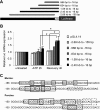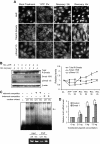Transcriptional control of human antigen R by bone morphogenetic protein
- PMID: 20018854
- PMCID: PMC2836048
- DOI: 10.1074/jbc.M109.062216
Transcriptional control of human antigen R by bone morphogenetic protein
Abstract
Human antigen R (HuR) is an RNA-binding protein with protective activities against cellular stress. This study considers the mechanisms by which HuR transcriptional regulation occurs in renal proximal tubule cells. Under basal conditions, HuR mRNA is expressed in two forms: one that contains a approximately 20-base 5'-untranslated region (UTR) sequence and one that contains a approximately 150-base, G+C-rich 5'-UTR that is inhibitory to translation. Recovery from cellular stresses such as thapsigargin and ATP depletion induced increased expression of the shorter, more translatable transcript and decreased expression of the longer form. Analysis of HuR upstream regions revealed sequences necessary for regulation of the shorter mRNA. Within the long, G+C-rich 5'-UTR exist multiple copies of the alternate Smad 1/5/8-binding motif GCCGnCGC. Recovery from ATP depletion induced increases in Smad 1/5/8 levels; further, gel shift and chromatin immunoprecipitation analyses demonstrated the ability of these Smads to bind to the relevant motif in the HuR 5'-UTR. Transfection of exogenous Smad 1 increased HuR mRNA expression. Finally, HuR mRNA expression driven by the Smad-binding sites was responsive to BMP-7, a protein with known protective effects against ischemic injury in kidney. These data suggest that transcriptional induction of a readily translatable HuR mRNA may be driven by a mechanism known to protect the kidney from injury and provides a novel pathway through which administration of BMP-7 may attenuate renal damage.
Figures




Similar articles
-
HADHB, HuR, and CP1 bind to the distal 3'-untranslated region of human renin mRNA and differentially modulate renin expression.J Biol Chem. 2003 Nov 7;278(45):44894-903. doi: 10.1074/jbc.M307782200. Epub 2003 Aug 21. J Biol Chem. 2003. PMID: 12933794
-
Expression of the RNA-stabilizing protein HuR in ischemia-reperfusion injury of rat kidney.Am J Physiol Renal Physiol. 2009 Jul;297(1):F95-F105. doi: 10.1152/ajprenal.90632.2008. Epub 2009 May 6. Am J Physiol Renal Physiol. 2009. PMID: 19420108 Free PMC article.
-
Expression and distribution of HuR during ATP depletion and recovery in proximal tubule cells.Am J Physiol Renal Physiol. 2006 Dec;291(6):F1255-63. doi: 10.1152/ajprenal.00440.2005. Epub 2006 Jun 20. Am J Physiol Renal Physiol. 2006. PMID: 16788138 Free PMC article.
-
BMP-Smad 1/5/8 signalling in the development of the nervous system.Prog Neurobiol. 2013 Oct;109:28-41. doi: 10.1016/j.pneurobio.2013.07.002. Epub 2013 Jul 24. Prog Neurobiol. 2013. PMID: 23891815 Review.
-
Structural, biological, and biomedical implications of mRNA interactions with the master regulator HuR.NAR Mol Med. 2025 Feb 3;2(1):ugaf002. doi: 10.1093/narmme/ugaf002. eCollection 2025 Jan. NAR Mol Med. 2025. PMID: 39980665 Free PMC article. Review.
Cited by
-
Functional interplay between RNA-binding protein HuR and microRNAs.Curr Protein Pept Sci. 2012 Jun;13(4):372-9. doi: 10.2174/138920312801619394. Curr Protein Pept Sci. 2012. PMID: 22708488 Free PMC article. Review.
-
Integrated Bioinformatics Analysis Identifies ELAVL1 and APP as Candidate Crucial Genes for Crohn's Disease.J Immunol Res. 2020 Jul 17;2020:3067273. doi: 10.1155/2020/3067273. eCollection 2020. J Immunol Res. 2020. PMID: 32724827 Free PMC article.
-
Krüppel -like factor 8 is a stress-responsive transcription factor that regulates expression of HuR.Cell Physiol Biochem. 2014;34(2):519-32. doi: 10.1159/000363019. Epub 2014 Aug 8. Cell Physiol Biochem. 2014. PMID: 25116351 Free PMC article.
-
HuR inhibits apoptosis by amplifying Akt signaling through a positive feedback loop.J Cell Physiol. 2013 Jan;228(1):182-9. doi: 10.1002/jcp.24120. J Cell Physiol. 2013. PMID: 22674407 Free PMC article.
-
Human antigen R and drug resistance in tumors.Invest New Drugs. 2019 Oct;37(5):1107-1116. doi: 10.1007/s10637-018-00723-x. Epub 2019 Jan 5. Invest New Drugs. 2019. PMID: 30612309 Review.
References
-
- Palmer B. F. (1997) J. Investig. Med. 45, 346–361 - PubMed
-
- Bonventre J. V. (2003) J. Am. Soc. Nephrol. 14, (Suppl. 1) S55–S61 - PubMed
-
- Supavekin S., Zhang W., Kucherlapati R., Kaskel F. J., Moore L. C., Devarajan P. (2003) Kidney Int. 63, 1714–1724 - PubMed
-
- Zeisberg M., Hanai J., Sugimoto H., Mammoto T., Charytan D., Strutz F., Kalluri R. (2003) Nat. Med. 9, 964–968 - PubMed
Publication types
MeSH terms
Substances
Grants and funding
LinkOut - more resources
Full Text Sources
Miscellaneous

